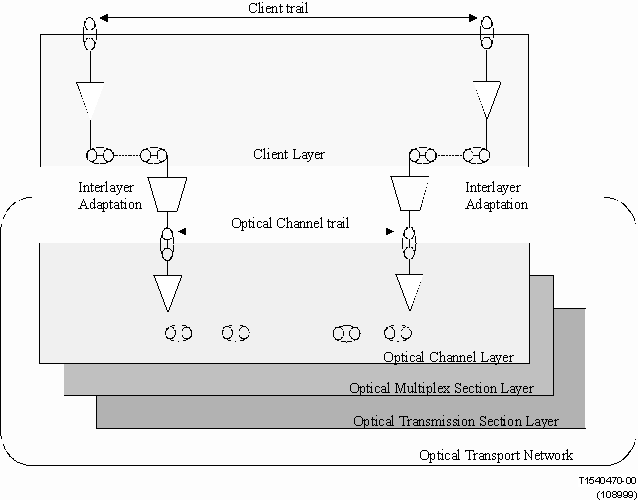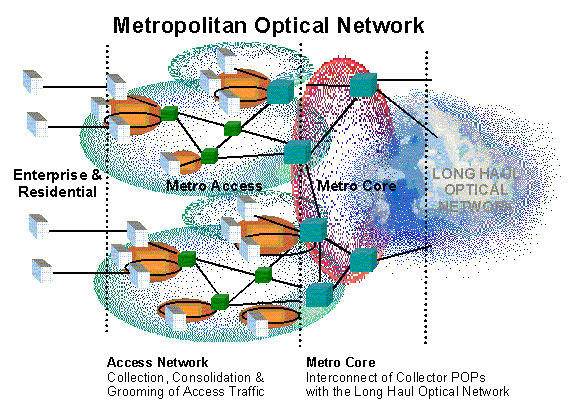|
One of the most complicated factors of coordinating work of multiple
organizations in the area of OTNT are the differences in terminology.
Often multiple different groups are utilising the same terms with
different definitions. This section includes definitions relevant to this
document. See Annex A for more information on how common terms are used in
different organizations.
1. Optical Transport Networks & Technologies
(OTNT)
The transmission of information over optical media in a systematic
manner is an optical transport network. The optical transport network
consists of the networking capabilities and the technology required to
support them. For the purposes of this standardization and work plan, all
new optical transport networking functionality and the related
technologies will be considered as part of the OTNT Standardization Work
Plan. The focus will be the transport and networking of digital payloads
over fiber optic cables. Though established optical transport mechanisms
such Synchronous Digital Hierarchy (SDH) may fall within this broad
definition, only standardization efforts relating to new networking
functionality of SDH will be actively considered as part of this Lead
Study Group activity.
2. Optical Transport Network (OTN)
An Optical Transport Network (OTN) is composed of a set of Optical
Network Elements connected by optical fibre links, able to provide
functionality of transport, multiplexing, routing, management, supervision
and survivability of optical channels carrying client signals, according
to the requirements given in Recommendation G.872.
A distinguishing characteristic of the OTN is its provision of
transport for any digital signal independent of client-specific aspects,
i.e. client independence. As such, according to the general functional
modeling described in Recommendation G.805, the OTN boundary is placed
across the Optical Channel/Client adaptation, in a way to include the
server specific processes and leaving out the client specific processes,
as shown in Figure 2-1.
NOTE - The client specific processes related to Optical Channel/Client
adaptation are described within Recommendation G.709.

FIGURE 2-1/OTNT: Boundary Of An Optical Transport Network And
Client-Server Relationship
3. Metropolitan Optical Network (MON)
A metropolitan optical network is a network subset, often without
significant differentiation or boundaries. Therefore an explicit
definition is under study. As a result, this section offers more of a
description than a formal definition for those who wish to better
understand what is commonly meant by "metropolitan optical
networks."
While the existence of metropolitan networks is longstanding, the need
for identification of these networks as distinct from the long haul
networks in general, as well as the enterprise and access networks is
recent. The bandwidth requirements from the end customers have been
increasing substantially and many are implementing high bandwidth optical
access connections. The resulting congestion and complexity has created a
growing demand for higher bandwidth interfaces for inter office solutions.
This aggregation of end customer traffic comprises a Metropolitan Optical
Network (MON). MONs now have the technology to be optical based and thus,
in theory, use the same technology over the fibres as other portions of
the network. However, this is not always the case as there are various
market forces that drive which technologies will be deployed in which part
of the network. As a result, it is appropriate to describe the MON in a
way that is agnostic to the various technology approaches. In spite of the
many similarities, there are several distinctions between metropolitan and
long haul optical networks (LHONs) that result from the aggregation of
traffic from enterprise to metro to long haul networks as shown in Figure
3-1.
- The first distinction is that MONs are inherently designed for
short to medium length distances in metropolitan areas. That is,
typically, within the limits of a single optical span and often less
than 200km distance. As a result, topics such as signal regeneration,
in-line amplification and error correction are of lesser importance
than in LHONs.
- Secondly, the driving requirement for MONs is maximized coverage
commensurate with low cost connectivity (as opposed to grooming for
performance with LHONs). As a result, for example, standardization
focuses on the adaptation of local area network technologies to be
effectively managed by service providers, on ‘insertion loss’
amplification to recover from all the connection points, and on ring
deployment to leverage existing fibre plant.
- Another key difference is that of service velocity. The demand
for fast provisioning results in the circuit churn rate being
generally higher in MONs than LHON. That combined with the wider
variety of client signals is a key driver for flexible aggregation
(e.g., 100Mb-1Gb rate, all 8B/10B formats with one card).
- A final distinction is that in the MON there are service
requirements (e.g., bandwidth-on-demand services, and multiple
classes-of-services) that lead to further topology and technical
considerations that are not a priority for LHONs.
While there are many combinations of technologies that can be used in
MONs, the following are common examples:
SONET/SDH
DWDM, CWDM
Optical Ethernet
Resilient Packet Ring
APON and EPON
As a result of the importance of MONs, SG15 has redefined several of
its Questions work programs to specifically include metro characteristics
of optical networks.

FIGURE 3-1/OTNT: Possible Relationship of MON and LHON
|